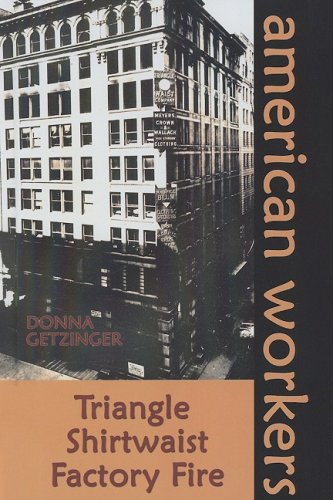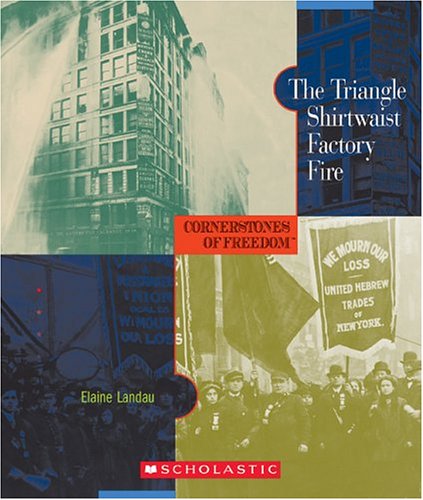-
The Triangle Shirtwaist Factory Fire
Adam R Schaefer, Sabrina Crewe, Sadrina Crewe
Library Binding (Gareth Stevens Pub Learning library, Jan. 1, 2004)Discusses the 1911 fire that destroyed New York City's Triangle Shirtwaist Factory and killed over one hundred workers, and looks at its causes and the reforms that came as a result of the tragedy. Q
Q
-
The Triangle Shirtwaist Factory Fire
Jessica Gunderson, Charles Barnett III, Phil Miller
Paperback (Capstone Press, Sept. 1, 2006)Tells the story of the fire at the Triangle Shirtwaist factory in New York City on March 25, 1911. Written in graphic-novel format. R
R
-
The Triangle Shirtwaist Factory Fire
Jessica Gunderson, Charles Barnett III, Phil Miller
Library Binding (Capstone Press, Jan. 1, 2006)Tells the story of the fire at the Triangle Shirtwaist factory in New York City on March 25, 1911. Written in graphic-novel format. R
R
-
The Triangle Shirtwaist Factory Fire: Flames of Labor Reform
Michelle Houle, Nelson Runger, Recorded Books
Audible Audiobook (Recorded Books, Nov. 5, 2013)Early in the 20th century, hundreds of New Yorkers - mostly women - worked in perilously cramped conditions at the Triangle Shirtwaist Factory. On March 25, 1911, disaster struck when a fire spread quickly through the building. One stair well exit was blocked by flames. Another exit was closed and locked - to keep employees from stealing. Many people jumped to their deaths from the building's ninth floor to avoid being burned alive. Others perished when the over loaded fire escape collapsed. After the blaze finally stopped, 146 people were dead - and the flames of labor reform were ignited . Soon, new safety and workers ' compensation laws were created. And in just a few months, the American Society of Safety Engineers was created to improve conditions in the workplace. In this powerful book, author Michelle M. Houle provides a vivid re-creation of this terrible event and also details the reforms it triggered. Nelson Runger - acclaimed for his nonfiction readings - delivers an unforgettable narration.
-
The Triangle Shirtwaist Factory Fire
Marc Tyler Nobleman
Library Binding (Compass Point Books, Jan. 1, 2008)Nobleman, Marc Taylor U
U
-
The Triangle Shirtwaist Factory Fire
Donna Getzinger
Library Binding (Morgan Reynolds Pub, June 1, 2008)Describes the dangerous conditions in the textile industry in the early 20th century behind the fire at the Triangle Shirtwaist Company that led to the death of many young women, and explains its impact on the labor movement and on society. S
S
-
The Triangle Shirtwaist Factory Fire
Jacqueline Dembar Greene
Library Binding (Bearport Pub Co Inc, Jan. 1, 2007)As factory workers prepared to go home after a long day at the Triangle Waist Company, Eva Harris suddenly cried out "fire!" Smoking flames near a fabric cutting table jumped to overflowing bins of cloth scraps, soon igniting the factory. Trying to escape the flames, many panicked workers jumped to their deaths as firefighters raced to the scene. In The Triangle Shirtwaist Factory Fire, kids will read about one of the worst factory fires in U.S. history through the narratives of those who experienced the March 1911 tragedy. Readers will discover what caused the fire, and learn how new safety regulations and procedures help prevent such deadly tragedies today. A series of primary-source quotes from witnesses reveal the human drama, while a "Profiles" section lists people related to the fire. S
S
-
The Triangle Shirtwaist Factory Fire
Elaine Landau
Paperback (Childrens Pr, March 1, 2009)Explains what sweatshops are and provides details of the fire that destroyed a New York City company, which later led to important fire safety laws. T
T
-
The Triangle Shirtwaist Factory
Charity Barger
language (, July 28, 2008)It is 1911. 500 women and children and 100 men march into the Triangle Shirtwaist Factory for another day of hard labor. Amongst the masses is Susan Watson, but unlike the other tired faces in the crowd, she has a lot to hope for. She has fallen in love with David Wilson, the owner's nephew. Although their relationship brings a lot of hardships, Susan and David find a love in each other that they have both been searching for. Just as it seems they have finally conquered all obstacles standing in their way, a fire erupts and they are to face the biggest trial of their lives.
-
The Triangle Shirtwaist Factory Fire
Brenda Lange
eBook (Chelsea House Publications, June 1, 2008)Conditions were harsh in tenement factories all over New York City, but they were especially difficult at one in particular. The Triangle Shirtwaist Factory, located near the city's Washington Square Park, made history on March 25, 1911, when a devastating fire destroyed the top three floors of the building in which it was located.
-
Fire at the Triangle Factory
Holly Littlefield, Mary O'Keefe Young
Paperback (First Avenue Editions TM, Aug. 1, 1991)Six days a week Minnie and Tessa sit, shoulder to shoulder, bent over sewing machines in a big room overflowing with piles of fabric, patterns, and lace. There is no fresh air, the light is dim, and there are too many people in the room. The work is hard and the days are long. Minnie and Tessa work at the Triangle Shirtwaist Company in New York City. The two fourteen-year-olds are best friends. It isn't easy for a Jewish girl and a Catholic girl to be friends in 1911--some people think they're just too different. But Minnie and Tessa must depend on that friendship when the Triangle factory goes up in flames and they are trapped on the ninth floor. This moving story of courage and friendship is based on true accounts of the tragic Triangle Shirtwaist Company fire of March 25, 1911. P
P
-
The Triangle Shirtwaist Factory Fire
Elaine Landau
Library Binding (Childrens Pr, March 1, 2005)Explains what sweatshops are and provides details of the fire that destroyed a New York City company, which later led to important fire safety laws. T
T